Dr. Walter Brenner, Master Bond, Inc.
An overview of the key characteristics of optical epoxies, including where each type can be used and how to choose among them
Technology in the optics industry has steadily advanced over the past several years, which can make the process of selecting an adhesive very complex, considering the number of factors now involved.
Epoxies frequently are used for bonding, sealing, coating and encapsulating applications across optical, optoelectronic, medical and related industries. Given the vast range of properties that epoxy materials offer, perhaps an efficient and effective way to choose a formulation is to explore some of the more significant properties of these systems before and after curing. Before curing, these range from color and viscosity to working life and mix ratios. After curing, optical properties, chemical and temperature resistance, and flexibility are among the features of paramount importance in selecting an optical adhesive.
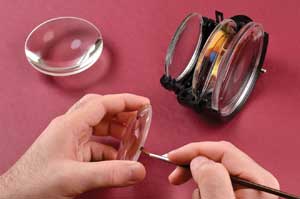
Optical properties such as light transmission at various wavelengths are important considerations when choosing epoxies. Various grades of epoxy adhesives offer different light-transmission properties.
One- and two-component epoxies
Epoxies are arguably the most versatile and widely used polymers for high-tech applications. They offer outstanding physical attributes, including high physical strength, good chemical resistance, excellent adhesion to a variety of substrates, broad temperature resistance and the ability to cure in thicker sections for sealing and encapsulation applications. In selecting the best system for a particular application, trade-offs are an inevitable and important consideration. Epoxies can be formulated
to be more flexible, but this can compromise some of their temperature resistance.
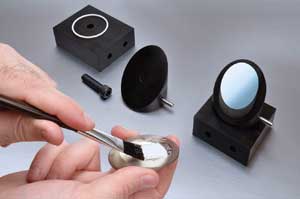
Two-component epoxies can be cured at room temperature (or slightly higher). Such room-temperature-curing nondrip adhesives are gap filling and adhere well to heat-sensitive substrates.
The most basic trade-off is found when deciding between a one- or two-part epoxy because each has its own set of challenges; e.g., two-part epoxies must be mixed, which often requires precise measuring by weight of each component, although some systems are very forgiving and can be mixed by volume. Two-component epoxies cure at ambient temperatures, or faster at elevated temperatures, as desired; this may be their most attractive feature.
One-component epoxies eliminate the need for mixing, but they can cure only with the addition of heat (250-300 °F).
Because one-part materials require this heat cure, they also offer the tremendous benefit of unlimited working life at room temperature. By comparison, the working life of two-component epoxies is limited.
Despite their differences, two-component epoxies are used far more regularly in optical applications because of their versatility and room-temperature (or slightly higher) curing. This is particularly significant in optical applications because many of the components can be heat-sensitive.
Curing epoxies
The curing of epoxies is a polymerization or cross-linking reaction. One-part systems require heat curing, typically at 125 °C or higher, although some newer systems will cure at 80 °C.
Moreover, the cure cannot simply be initiated with heat and then left to finish at ambient temperatures. It is important to let the epoxy fully cure with heat, or the curing process will stop.
For two-part epoxies, cure times can be broken down into three stages:
• Open: the time that one has to use the material after mixing parts A and B together.
• Handling: the time it takes for the adhesive to set up so that the parts being bonded can be moved. This is also known as fixturing time.
• Cure: the time it takes to “fully” cure.
Most two-part epoxies will fully cure at room temperature; depending upon the system, this often can take many days. The speed of cure can be accelerated by adding heat (50-100 °C), which results in additional polymerization and can give the epoxy better properties. There also are some highly specialized two-part epoxies that require a heat cure and provide outstanding physical properties that could not be achieved by a more conventional system.
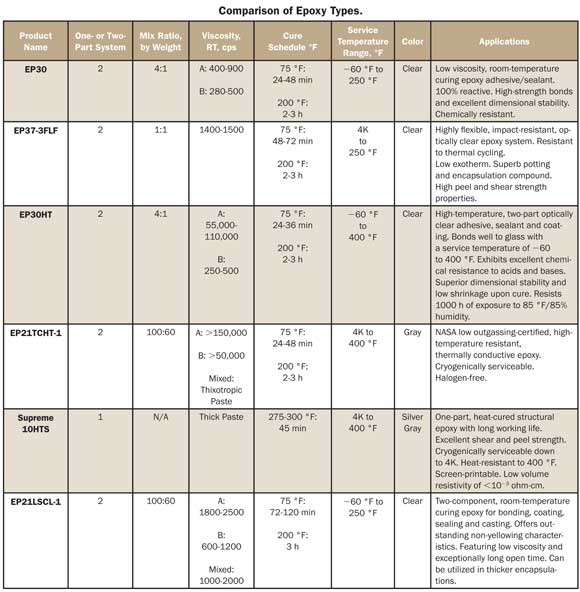
Properties of epoxies before curing
Although there is a propensity to focus more on the final properties of the epoxy once it is cured, it is just as important to evaluate precuring requirements. Some of the more pertinent aspects include color, viscosity and exotherm generation while curing.
Both one- and two-part epoxies vary in color from transparent to opaque. For optical applications, the tendency is to think that you always need optical clarity, but this is not necessarily so. There is no hard-and-fast rule for color; it depends on the application. Some applications require a transparent product; for others, amber clear is acceptable as long as light transmission is good. In still other scenarios, opaque systems are needed. For example, in certain optoelectronics applications, thermal conductivity is the salient property, and optical clarity must become a secondary issue because thermally conductive epoxies are opaque. Optical clarity also is not normally required when bonding a mirror to metal.
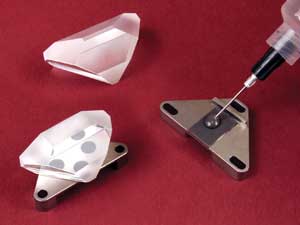
Optically clear epoxies have excellent light transmission from 0.35 to 2.2 µm.
Viscosity is another critical factor in the epoxy selection process. In certain applications, the material should be very thin or watery; e.g., when it must enter a narrow gap.
In other situations, a more moderate viscosity or even a paste is desirable, which is particularly true for bonding applications. This tends to be the case with one-part epoxies, because when heat is added to cure the material, the epoxy’s flow increases.
In general, the best viscosity for an application requires careful consideration of the usage itself. The most fundamental decision is whether the end user is bonding, sealing, coating or potting. Next, the specifics of the application must be examined, including the shapes of the parts and their dimensions. Ultimately, the choice depends upon a whole host of factors, including dimensions, the nature of the application, how the material will be applied and what properties are required after cure, among others. There also is an element of subjectivity and the end user’s comfort zone in this process, because it may be necessary to employ the trial-and-error approach to find the viscosity that best suits the application.
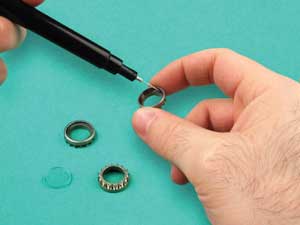
Low-viscosity epoxies can be used as adhesives for designs where the gaps between substrates are small (two- to five-thousandths of an inch).
Another major factor (often overlooked) to consider in the selection process is the exotherm created when mixing parts A and B together. Systems that generate lower exotherm when mixed consistently have longer open times, cure more slowly and can be used for thicker encapsulations. Conversely, systems generating higher exotherm have a far more limited working life, cure more quickly and cannot be used in thicker sections.
Of two-part epoxies, engineers commonly say, “Faster is better,” but more often than not, this isn’t the case. For example, if long open times are needed or thicker sections are being cast, a faster system is a nonstarter because of the higher exotherm of rapidly curing epoxies. One-part compounds are inherently higher in exotherm and are customarily difficult to cure in sections up to and beyond 1/4 in. thick. However, two-part materials can easily cure in sections up to an inch and beyond, making them more suitable for potting applications. In general, however, the larger the mass of epoxy being cured, the greater the exotherm.
Properties of epoxies after curing
Besides polymerization, salient issues for epoxies include optical properties such as light transmission at various wavelengths. Light transmission values from 200 nm up to 5 µm are of particular interest to many optical engineers. Nearly all light-transmitting epoxies perform well from 350 nm to 2.5 µm. Above 2.5 µm, epoxies vary greatly in their ability to transmit light. Another optical property is index of refraction upon cure. This value normally ranges from 1.5 to 1.65.
Epoxies are exceptionally robust electrical insulators, although they can be formulated to be conductive. As insulators, they offer superb dielectric strength, dielectric constants, volume resistivity and dissipation factors as well as other electrically insulative properties. Epoxy versatility is exemplified by the fact that these insulators can be formulated to be thermally conductive and electrically insulative, or thermally and electrically conductive.
Chemical resistance is another strong suit of epoxies. They can withstand harsh environments when exposed to water, fuels, acids, bases and numerous solvents, many of which are aggressive.
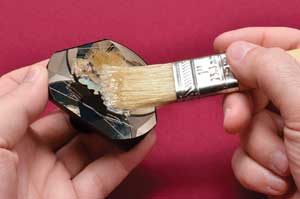
Epoxies also vary in hardness. Some epoxy formulations offer high tensile strength and dimensional stability.
One key reason that epoxies are widely chosen over other types of fasteners is their ability to withstand a wide range of temperatures. Select epoxies can resist cryogenic conditions; others are functional at higher temperatures up to 600 °F. Additionally, many excel in applications involving rigorous thermal cycling.
In optical applications, epoxies are especially noteworthy for being low outgassing, a quality highly desirable under vacuum conditions or when lenses, semiconductors or optical components are involved. Many epoxies pass the NASA low-outgassing test based on the ASTM C-595 standard, which takes place under vacuum conditions. Epoxies that have not been tested are usually considered “generically” low outgassing.
Hardness is another example of epoxy versatility. Although epoxies are thought of as rigid, many formulations offer varying degrees of toughness and flexibility. Flexible epoxies are particularly useful for bonding dissimilar substrates in conditions where rigorous thermal cycling is taking place. Rigidity is desirable in situations demanding dimensional stability, machining and polishing.
Meet the author
Dr. Walter Brenner is technical director at Master Bond Inc. in Hackensack, N.J.; email: [email protected].